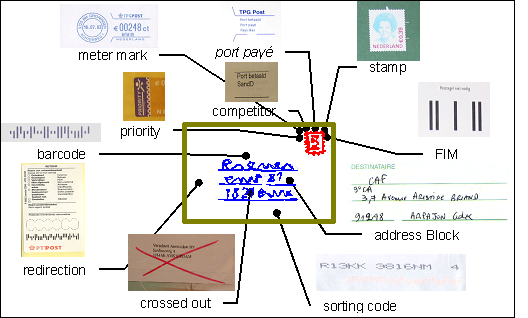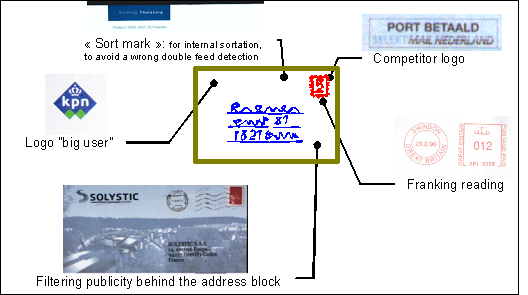
The new frontier of Postal Automatic Recognition:
World Mail Review November 2008 Since the early days of Postal Automation history, automatic recognition of the delivery address has been one of the key-factors affecting sorting efficiency. More than 30 years of development have been spent to deal with address recognition, either machine printed and handwritten. Those developments have been carried out by introducing multiple recognition algorithms, and taking advantage of regular progress of hardware technology, providing more and more high computing power in commercial on-the-shelf products.
In the Seventies, the technology available at an affordable price was only sufficient to enable the reading of machine printed addresses written in a standardised format. Address writing rules were specified in order to allow an “acceptable” accuracy level (e.g., use of fixed-pitch character fonts, authorised distance between words, lines, specification of printing contrast ratio, etc).
Later in the Eighties, developments of more powerful algorithms were carried out in association with the introduction of more powerful computing capabilities. Dedicated parallel hardware platforms were designed in order to provide high power computing levels. The aim was to develop the recognition of handwritten addresses. Again, at the beginning of this phase, rules were introduced in order to improve the reading performance (e.g., pre-printed boxes for the postal code, lines for the address, etc).
Since the Nineties, further developments allowed to dramatically increase the quantity of machine-readable information. Consequently, the depth of automatic coding increased from outward level (i.e., usually, postal zone or district level) to inward one (i.e. correct destination right down to delivery postman level) and then up to the finest sorting level: the delivery point (a single mailbox or other place at which mail is delivered).
The objective was to deal with more and more unconstrained writing of machine-printed and handwritten addresses, in order to increase the spectrum of items to be processed without any assistance of manual data encoding. Nevertheless, up to now, there are still algorithms developments in progress in order to deal with addresses written in a non standard form – even containing errors either due to human being or to the content of the postal data files used for checking the accuracy of the address.
The on-going developments are now oriented to respond to more sophisticated requirements of Postal Operators. Due to the forthcoming full postal market liberalisation, the competition between operators requires higher flexibility in the management of existing systems and strong capabilities to propose new services. This requires dealing with all the information applied on the envelope during its entire life cycle: not only the complete address (including recipient’s name), but also franking, meter mark, various indicia, stamps, airmail sticker, first class mail, second class mail, various codes (id-tag, routing, customer barcode, intelligent, etc..), address of the sender, return to sender information, cancellation information, “undeliverable as addressed”, redirection information, origin of the item, special delivery, advertisement, logos, registered, business reply, etc.
In the recent past, identification of some of these features has required specific modules or even dedicated devices. Moreover, once again, rules have been introduced in order to get higher performance: localisation of the information, printing contrast ratio, limitation of authorised variations, etc. Now, a similar improvement process as the one described for the address recognition is occurring. Existing constraints must be relaxed, and new features, associated with the introduction of new postal products and services, must be quickly taken into account. Finally, all reading capabilities must be integrated, in order to avoid any “specific device”. The final objective can be summarized like this: a complete, integrated and “future safe” understanding of all pieces of information contained in a mailpiece.
This is exactly the direction of Solystic most recent efforts. At this time, proven solutions are already in live operation in postal environments, providing high performance in the capability to determine all the information available on a mail item (see fig 1 & fig 2).

fig 1 – Example of image analysis and mail information identification

fig 2 – Another example of image analysis and mail information identification
In order to get the highest performance level, Solystic solutions include various innovations and the up-to-date breakthrough technology.
The image acquired in colour now replaces the multi-grey image acquisition, which was the standard from the beginning. This is a major improvement: taking into consideration the colour parameter, it becomes much easier to identify and read different pieces of information.
Moreover, the internal architecture allows an easy integration of multiple algorithms. The experience acquired in address recognition shows that a key element is to be able to merge efficiently different results, generated from various sources. The challenge is still the same: to improve the read rate while keeping the error rate at a minimum level.
With these new capabilities, the Postal Operators can have a better knowledge of their complete mailstream and provide additional services to their customers. Here are just a few possible examples:
1. It becomes possible to easily get all information at various steps. A mailpiece can be analysed the first time it arrives at the sorting centre for segregation and outward sortation; but in the future, mailpiece might arrive directly at the delivery office pre-sorted by another postal operator, or even at the post office where the preparation for the final delivery (walk sequencing) is carried out. The detailed identification of all these parameters will become essential to fully detect and understand any changes in the mail flows and therefore to react promptly to the competition.
2. The data capture at all different mailstream processing steps enables to track and trace any individual mail pieces.
3. The knowledge of all accurate details printed on each mail piece will enable to recognize each item from the others. Therefore, there will be no more needs to apply a barcode on each item. This concept, recently introduced by Solystic, is called Virtual Identification (V-IdTM). V-IdTM will be beneficial for both the Postal Operator and the customer: for the Postal Operator as it meaningfully reduces the operational and maintenance cost (no ink, no printing device, higher reliability of the sorting equipment); for the final customer as there is no marking which can be perceived as degradation of the item itself.
4. An important need for the direct marketing is to apply additional information on the mail item in order to have a message oriented and dedicated to the recipient. This information will be seen as dedicated advertisement and, based on the capability to isolate this information from the address, will not have a detrimental effect on the capability to continue process the item automatically.
5. The stamps can now contain a user-defined image. In order to protect the postal operator revenue, it is important to continue have an efficient stamp detection even if the list of authorised stamps is increasing on a daily basis.
6. When mail is not delivered as addressed (UAA), the automatic detection and checking of returned items often marked as crossed out will enable to provide services to the original sender, by indicating the wrong or invalid address in its database without the constraint to return the physical item to the sender.
The forthcoming increased competition between postal operators requires being able to develop new and innovative customer-oriented products and services. The complete and detailed understanding of the content of all data printed on each individual mail piece is now a key element for this challenge.












